Could There Be More Than One Stupid Moon?

“Everybody knows that there’s just one moon orbiting the Earth. But a new study by an international team of astronomers concludes that everybody is dead wrong about that.”
— Somebody go read the rest of this and tell me what the deal is; I just don’t think I have the strength to face it today.
Photo by fotum, via Shutterstock
How To Identify "Lying Face"
If you want to know whether or not someone is lying to you, watch their upper face.
What Won The Championship For Kentucky?
What Won The Championship For Kentucky?

Last night it was pretty clear: The best team won. And along with the title, John Calipari’s Wildcats surely deserve consideration as one the best teams of the decade, rivaled only by the 2009 North Carolina squad and Duke in 2002. This season, Kentucky played superior defense, and they played unselfishly, two hallmarks of championship teams that deserve a special place in the conversation of “best ever.”
Of course, many fans around college basketball root against Kentucky; that’s just a fact. And it was already the case before Calipari arrived in Lexington. The program has deserved some of its bad reputation, most notably due to a massive recruiting scandal in the late ’80s. But the animus also stems from UK being one of those ‘bully’ programs, big and unabashedly so; not many folks root for Goliath over David unless they have some vested interest. But this edition of the Wildcats embraced their own dominance. And in a tournament that otherwise lacked some the drama we’ve come to expect — no buzzer-beaters and only one overtime game — Kentucky’s superior play was a welcome stand-out. Other than the opening Friday when a pair of 15 seeds shocked Missouri and Duke, the tourney went mostly as expected — and the final game did too. Kansas played hard, but Kentucky was simply stronger.
HOW THE CHAMPIONSHIP GAME WAS WON
Yes, Kentucky has a bevy of future pros. But as I’ve said before, it was the team’s defensive intensity in combination with those NBA skills that made the Wildcats so difficult to beat. Anthony Davis, the Kentucky freshman that has swept the national player of the year awards, shot only 1-of-10 and scored just six points in the title game yet was named Most Outstanding Player, confirming how he can impact a game without scoring. Davis had 16 rebounds — 12 on the defensive end — and six blocks to go along with five assists and three steals. He altered even more shots with his mere presence, as Kansas’ guards added too much arc and height to their shots with Davis in the back of their minds.
When the Jayhawks cut the lead to 10 midway through the second half, Kentucky sophomore Doron Lamb hit a pair of clutch three-pointers to keep his team firmly in control of the game. Lamb finished with 22 points. On a team with so many stars, as Kansas found, it’s nearly impossible to keep all of them in check. On this night, it was Lamb they couldn’t shut down.
WHEN THE FINAL WAS WON
With just over 10 minutes gone in the first half, Jayhawks guard Travis Releford canned a three to cut Kentucky’s early lead to just five at 23–17. Over the next eight minutes, the Wildcats outscored Kansas 14–4 and stretched the lead out to 16. While Kansas would cut the lead down to as few as five points later in the game, it was that early cushion that allowed the Wildcats to control the pacing and flow of the game for all but a few minutes.
Michael Kidd-Gilchrist, another freshman star for Kentucky, scored all 11 of his points in the first half, many of them during that important 14–4 run. His block with Kentucky clinging to a six-point margin in the waning minute of the game was also huge, all but ending the Kansas comeback threat.
WHO WAS THE GAME’S TRUE MOP?
Davis was the game’s MOP, and deservedly so. Lamb scored the most points of anyone on either team. Kidd-Gilchrist had a hand in the win for sure. But Kentucky’s most important player might have been freshman point guard Marquis Teague, who played calmly and efficiently in leading the Wildcats attack. Teague struggled earlier in the season as he adapted to the college game. The player that helped win a national title looked markedly different from — and was much more effective than — the one that charged into the lane with reckless abandon in November and December.
Kansas’ star forward Thomas Robinson deserves accolades for his performance on Monday night — 18 points and 17 rebounds — as he has this entire season. Senior guard Tyshawn Taylor also played well in defeat, hitting his first three-pointer of the tournament after 20 misses and finishing with a team-high 19 points.
Perhaps the game’s true MVP was Calipari, the coach who brought all that Kentucky talent together. The title had to be earned, of course, but it may have been won the day Davis, Teague, Kidd-Gilchrist and reserve freshman Kyle Wiltjer showed up on campus.
STUPIDLY EARLY TOP 5 FOR 2012–13
It’s always speculative to look at next season the moment this season finishes, but so what? Obviously the NBA Draft will wreak havoc on college coaching staffs and on absurdly early projections for next season. We got lucky this time last year when several of the top freshmen in college basketball opted to return. We may not be so fortunate this time around.
1. Indiana: After finishing the season with 27 wins and a Sweet 16 finish, the Hoosiers will be overlooked no more. Assuming that star forward Cody Zeller decides not to enter his name into the NBA Draft, Indiana will be loaded heading into next season. Christian Watford, Victor Oladipo, Jordan Hulls and Will Sheehey all return, and a stud recruiting class of Hanner Parea, Kevin “Yogi” Ferrell and Jeremy Hollowell will add talent and depth to the roster. Expectations will be high for coach Tom Crean and his team this fall.
2. Baylor: It’s probable that super sophomore Perry Jones III will declare for the draft, but much talent remains in Waco. Brady Heslip, Pierre Jackson, Quincy Miller and Deuce Bello are back after an Elite Eight finish and seven-footer Isaiah Austin will slot into the lineup as this season’s marquee Baylor freshman. Coach Scott Drew keeps inking blue-chip players and a breakthrough season seems inevitable.
3. Michigan: If John Beilein can convince star freshman Trey Burke to return to campus for another go around, the Wolverines will be stacked. Tim Hardaway Jr. averaged nearly 15 points a game this season and Mitch McGary and Glenn Robinson III arrive as top freshmen to add size and scoring pop to the Michigan attack. If Burke returns, Beilein will have the most talented team he has ever coached.
4. Louisville: Folks in and out of Louisville were surprised when the Cardinals made it to the Final Four this season, but they shouldn’t be surprised if Rick Pitino’s team finds itself playing on the tournament’s final weekend again next year. Peyton Siva will return to drive Louisville on both ends and center Gorgui Dieng will have another offseason to work on his burgeoning offensive game. Chane Behanan and Wayne Blackshear will be sophomores and the coach is still named Pitino. Expect another season of intense defense and likely a more fluid and dangerous offense next time around.
5. Kentucky: The national champions will likely lose Davis, Terrence Jones and Lamb to the NBA, and could very well see Kidd-Gilchrist and Teague bolt as well. But Calipari recruits with defections in mind and he has top talent set to come in. Ryan Harrow, a former McDonald’s All-American who now has a season in the system, transfers in from NC State. All-American freshmen Archie Goodwin and Alex Poythress take over for Davis and Jones and most recruiting observers think that the Wildcats will get another two or three major unsigned recruits in the late signing period, meaning that another young, talented Kentucky team will be aiming squarely at the 2013 title.
Originally from Kentucky, Joshua Lars Weill now writes from Washington, DC. His take on things can be found at Agonica and on Twitter. Photo by kmo, via Flickr.
Pandas Would Rather Do Anything Else Than Sex
You can lead a panda to the love tunnel, but you can’t make him screw.
Is Lady Pretty? World Rushes To Debate
“While I’m no Elle Macpherson, I’m tall, slim, blonde and, so I’m often told, a good-looking woman. I know how lucky I am. But there are downsides to being pretty — the main one being that other women hate me for no other reason than my lovely looks.”
— Who could have imagined that this would not go over well?
The Riddle Of Mark Twain's Passion For Joan Of Arc
The Riddle Of Mark Twain’s Passion For Joan Of Arc
by Daniel Crown
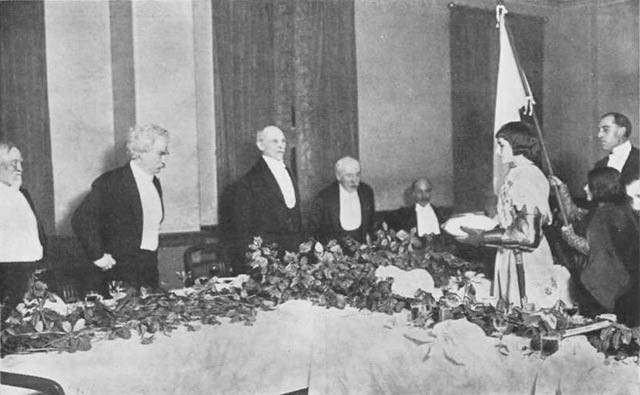
On a December night in 1905, the New York City chapter of the Society of Illustrators managed to do something many thought impossible. With one calculated stroke they left Mark Twain, author and noted quipster, speechless.
The writer had just risen to address the group. As he began to speak, a girl emerged from the back of the room. Her hair was cropped just below her ears; her face was angular but radiant. Underneath a ceremonial white robe, she wore the armor of a 15th-century French soldier. With eyes fixed on the author, she glided up the aisle between the tables carrying a laurel wreath atop a satin pillow. A reporter from The New York Times in attendance that night later wrote that the “company smile” Twain had exhibited for most of the ceremony faded. By the time the girl reached his table, “Twain had every appearance of a man who had seen a ghost. His eyes fairly started out of his head, his hand gripped the edge of the table.” She presented the author with the wreath, and he accepted it wordlessly. He remained silent until the model exited the room. As the seconds ticked away, Twain’s audience anxiously awaited his response.
When the writer finally spoke, he did so slowly, carefully.
“Now there’s an illustration, gentlemen — a real illustration. I studied that girl, Joan of Arc, for twelve years, and it never seemed to me that the artists and the writers gave us a true picture of her. They drew a picture of a peasant. Her dress was that of a peasant. But they always missed the face — the divine soul, the pure character, the supreme woman, the wonderful girl. She was only 18 years old, but put into a breast like hers a heart like hers and I think, gentlemen, you would have a girl — like that.”
***
Mark Twain’s obsession with Joan of Arc has to rank among the most baffling and least talked about enigmas in American literature. Even for those entrenched within the competitive world of Twain scholarship, stories like the one above are usually treated as interesting, but ultimately trifling, anecdotes, illustrative of the eccentricities of a predictably unconventional man.
The same might also be said of his book about the French heroine. Published in 1896, when its author was 61, Personal Recollections of Joan of Arc has long been viewed as something of an aberration, a curio — the type of genre-bending work that a bored, established writer often undertakes in order to buck audience expectations. Narrated by a fictionalized version of Joan’s servant and scribe, Sieur Louis de Conte, the book spans the majority of Joan’s life, beginning with her childhood in eastern France and ending with her questionable trial and execution. While other Twain novels such as A Connecticut Yankee in King Arthur’s Court and The Prince and the Pauper are also set in medieval Europe, far from the author’s more familiar milieu of mid-19th century Missouri, Recollections is unique in its somber tone.
Take the following passage, drawn from the book’s climactic trial scenes:
Of course I had been expecting such news every day for many days; but no matter, the shock of it almost took my breath away and set me trembling like a leaf. I suppose that without knowing it I had been half imagining that at the last moment something would happen, something that would stop this fatal trial: maybe that La Hire would burst in at the gates with his hellions at his back; maybe that God would have pity and stretch forth His mighty hand. But now — now there was no hope.
At the time Recollections was published, Twain was mostly known for humor and satire. And while the early chapters of Recollections have moments of whimsy, such as when Twain’s narrator observes Joan interacting with forest fairies, by the time the Maid of Orleans dons her famous armor, the author has abandoned all fancifulness.
The book has puzzled critics for over a century. Susan K. Harris, a Twain expert who teaches at the University of Kansas, helped produce the novel’s 1996 Oxford University Press edition. As she pointed out to me, “By the time he’s writing Recollections, he’s not a believer. He is anti-Catholic, and he doesn’t like the French. So he writes a book about a French-Catholic-martyr? Ostensibly, it doesn’t make a lot of sense.”
Logical or not, Twain’s passion for Joan of Arc was longstanding, and his public praise of her lavish. Writing in a 1904 Harper’s essay, he referred to her as “by far the most extraordinary person the human race has ever produced.” In the same piece, he christened her “The Miracle Child” and “The Wonder of the Ages.”
His pride in Recollections was equally unrestrained. Writing in his 1985 memoir Our Neighbor, Mark Twain, Coley Taylor — a neighbor of Twain’s in Redding, Connecticut, where the author lived from 1908 until his death in 1910 — told the story of the day when he, then a young boy, approached the writer in order to profess his adulation for Twain’s most famous characters: Tom Sawyer and Huckleberry Finn. Upon hearing the boy’s praises, the author suddenly took on the mien of a vexed schoolteacher. In the moment, Twain must have reminded Taylor of Huckleberry Finn’s remonstrative Widow Douglas: “You shouldn’t read those books about bad boys,” he told the child, wagging his finger in Taylor’s face. “My best book is my Recollections of Joan of Arc.”
***
According to Twain’s first true biographer, Albert B. Paine, in his later years the author favored telling one particular story over the hundreds of other doozies he’d acquired over his lifetime. Like most of Twain’s “true-life” anecdotes, this one flirted with exaggeration; though, for all of its apparent embellishments, its listeners were inclined to believe it, if only because they wanted to.
The story went something like this:
As a young boy in Hannibal, Missouri, a wayward page from a tattered book once blew across young Samuel Clemens’ path as he made his way home from a shift as an apprentice for a local printer. For reasons beyond his understanding, the boy, then maybe 12 or 13, felt compelled to snatch the loose paper from the air. Reading down the page, he stopped in his tracks, then sought out a place to sit on the ground where he could devour its every word.
The scene captured on that errant page was a piquant one; it told of a young French girl caught in a desperate debate with a pair of English rogues. The girl was caged, and wearing nothing but crude undergarments. The brutes who had stolen her clothes were doing their best to rile their prisoner, to little avail.
“There arose within Twain a deep compassion for the gentle Maid of Orleans, a burning resentment toward her captors, a powerful and indestructible interest in her sad history.”
As Paine picks up the tale, the boy then ran home and immediately began questioning his family about what on earth this mysterious heroine might possibly have done to be imprisoned within a cage. The family knew little of her but, regardless, by the end of the night: “There arose within Twain a deep compassion for the gentle Maid of Orleans, a burning resentment toward her captors, a powerful and indestructible interest in her sad history. It was an interest that would grow steadily for more than half a lifetime and culminate at last in that crowning work, the Recollections, the loveliest story ever told of the martyred girl.”
Paine, very clearly, took Twain’s story at face value. Modern scholars are more skeptical.
“Frankly, I don’t know how much stock to place in that story,” Linda Morris, a professor at UC-Davis, told me. “But what we do know is that Twain was very, very serious about Joan, and that he conducted enormous amounts of research on her.”
While most references to Joan in Twain’s work crop up after Recollections’ publication — when she’s mentioned in such essays as, “How to Make History Dates Stick,” “Christian Science,” “The Turning Point of My Life,” and the aforementioned 1904 Harper’s essay, “Joan of Arc” — the Maid of Orleans does make a few appearances in some of Twain’s earlier work.
One of the first is in his “Speech at the Scottish Banquet,” which was first transcribed and published by the London Observer in 1872. In the speech Twain waxes poetic about Victorian femininity, then praises Joan as the ultimate symbol of female leadership, asking, “Who was more patriotic than Joan of Arc? Who was braver? Who has given us a grander instance of self-sacrificing devotion?” She’s also included among the “great men” in the satirical essay, “Last Words of Great Men,” written in 1889.
While Twain would later claim to have conducted twelve years of research on Joan of Arc before beginning his novel, historians like Morris believe the bulk of his investigation was conducted during his prolonged stay in Europe during the early 1890s. This was shortly after financial troubles had forced him to abandon the longtime family home in Hartford. While the author and his family eventually settled in Berlin, he reportedly made multiple journeys to France during this period, where he sought out every volume on Joan of Arc that he could find. What makes this particularly noteworthy is that at the time he was doing his research, Joan’s story was not exactly well-traversed territory.
“Twain writes about her long before she is beatified [in 1909],” Morris said. “She was certainly in the public view in ways she had never been before, but there is no doubt that he is once again ahead of his time here.”
When Twain began his research, Joan of Arc had been dead for well over 400 years. Many of the same divisive issues that plagued her reputation during her lifetime — the accusations of heresy and the contrasting insinuations of her divine inspiration — had left her somewhat in flux, historically.
Twain seems to have drawn most of his information from two sources: the fifth volume of Jules Michelet’s epic Histoire de France and Jules Quicherat’s own Proces de condamnation et de rehabilitation de Jeanne d’Arc, the publication of which marked the first time in history Joan’s trial transcripts had been made available in their entirety. At the time, only Michelet’s volume was available in English, making Twain’s recounting of the trial scenes among the first to be written for an English-speaking audience. While two other Joan-centered books were released in America the same year as Recollections, that is 1896, Twain was by far the most famous author of the three. To most of his audience, Twain’s version would have been the most comprehensive telling of Joan’s story they’d ever read.
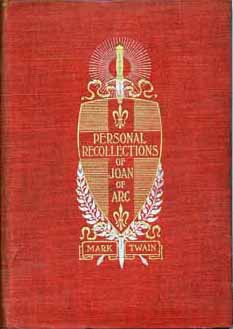
Personal Recollections of Joan of Arc first appeared before the reading public as a serial, running in Harper’s between April 1895 and April 1896. Wanting the work to be considered seriously, without any preconceived expectations, Twain had the magazine credit the story to the book’s narrator, de Conte. The ploy didn’t exactly go as planned.
By the time the book came out, now with Twain’s name on the cover, the consensus reaction seemed to reinforce the author’s worst fears. As Morris told me: “When people found out that it was his story, they immediately began to say things like, ‘But it isn’t funny. This isn’t Mark Twain’.”
Today, while not widely read, the book does have its adherents. Modern-day Joan of Arc enthusiasts read it. And many in the Catholic community claim the book as a religious work. (Steve Courtney, publications editor for the Mark Twain House & Museum in Redding, told me that he was recently surprised to find a copy of the novel sandwiched within a row of hymn books in a nunnery.)
According to Morris, however, the religious angle doesn’t add up. “He really doesn’t emphasize the piety or the voices [in Recollections]. He kind of keeps his hands off the spiritual side of things.”
***
Among many other claims to notoriety, Joan of Arc was also one of history’s most famous cross dressers. And it’s this element of her story, Morris contends, that helped draw Twain’s interest.
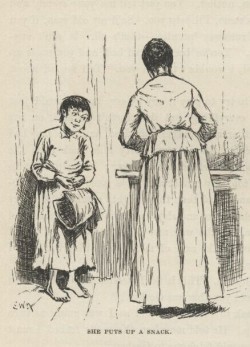
As she outlines in her book, Gender Play in Mark Twain: Cross-Dressing and Transgression, Twain made frequent use of cross-dressing in his fiction. One of the best-known examples comes in Twain’s masterpiece, Adventures of Huckleberry Finn. A key scene in one of the book’s early chapters finds Huck and Jim bunkered away in a cave, ducking the band of townies who assume the runaway slave is responsible for the boy’s apparent death. After a bit of misfortune with an unlucky rattlesnake, the two of them decide that Huck should go undercover in order to conduct a bit of reconnaissance to discover whether the mob might be on to them. For a disguise, they choose to dress the boy in full female attire, replete with a day-dress and a bonnet. Huck eventually works his way into the company of a local woman, Judith Loftus, alone in her family’s house. At first, things seem to go well. Judith lets go of plenty of useful tidbits, including the alarming fact that there’s a search party on its way to Jim’s island even as they speak.
Mrs. Loftus, of course, eventually sniffs Huck out. She does so not because of the child’s low voice, or even his boyish face, mind you. Huck’s true gender is revealed because he throws too well and he doesn’t know how to sew properly. Still, the disguise has already served its purpose. As Morris points out, “because Huck is masquerading as a girl, he gets all of the information he needs. Had he shown up as a boy, she wouldn’t have told him anything.”

Other examples can be found in a pair of short stories, now widely unread. The first, “An Awful, Terrible Medieval Romance,” originally published in 1870, tells the tale of a father who forces his daughter to pretend to be a boy in order to ascend the feudalistic social hierarchy. The second, an unpublished 1883 short story titled “The 1,002nd Arabian Night,” sets up a rather contrived premise wherein two babies of different sexes are switched at birth, living their new lives with reversed genders unbeknownst to those around them — this despite the fact that they often bathed together as young children and presumably at some point one of them would have looked down and noticed a difference.
In these earlier stories the act of cross-dressing is used as a droll plot device. But in Recollections the topic becomes deadly serious as cross-dressing itself is put on trial.
In the novel’s climactic courtroom scenes, Twain depicts Joan’s accusers as being fixated on the girl’s choice of clothing. To her prosecutors, her male dress represents her growing indifference toward accepted Catholic dogma. As the prosecution continues to rehash the issue day after day, Joan eventually becomes annoyed, proclaiming, “[The clothes are] a trifling thing and of no consequence. And I did not put them on by counsel of any man, but by the command of God.”
During the trial, Joan’s surprising aptitude for lawyerly argument helps her to fend off the prosecution’s charges. But soon her accusers find the soft spot in her armor (to use what feels an appropriate phrase): During her lengthy imprisonment, Joan had not been allowed to attend Mass. The prosecutors inform her that they’ll allow her to attend weekend services if she agrees to never again don men’s clothing. This is a trick, because, as the lawyers see it, any compliance with the proposal would amount to an admission of wrongdoing. If Joan’s clothes are unfit to wear in the presence of God, then they are inherently sacrilegious.
Joan refuses their offers multiple times, but her guilt over not taking communion ultimately takes its toll. With the signing of the infamous “form of abjuration,” she agrees to stop wearing male attire.
But Joan’s acquiescence is short lived. The following Monday, the judges visit the prison and find Joan dressed in a robe and a hood, both of which she’d sworn to throw away. This broken promise ultimately gives her inquisitors the excuse they need for her execution.
Faithful until the very end, Twain’s narrator, the scribe Sieur Louis de Conte, goes on to allege that the Church intentionally misrepresented the purpose of the male clothing from the onset, reporting that the only reason Joan re-donned the clothes was to shield her from the ogling eyes of her accusers. “It was shabby work for those grave men to be engaged in,” he says, “for they well knew one of Joan’s reasons for clinging to male dress was that soldiers of the guard were always present in her room whether she was asleep or awake and that the male dress was a better protection for her modesty than any other.”
***
It’s no accident that Twain chose to spin Joan’s cross-dressing as an exercise in modesty. His portrayal of Joan as a paragon of Victorian girlhood was in many ways a direct reaction to a tumultuous sea change happening around him. At the time that he was writing Recollections, the women’s suffrage movement was beginning to make strides in the United States; for the first time in history, men like Twain were forced to come to terms with what came to be called “The New Woman.”
As Susan Harris said: “This is the time when women are suddenly achieving progress. They’re getting Ph.Ds., they’re getting jobs, and they’re cutting their hair and riding bicycles. They’re starting to talk about sexuality and contraception. This put tremendous stresses and strains both on the women themselves, who were trying to move out from the Victorian paradigm into something new, as well as the culture that didn’t know how to deal with them.”
While Twain fancied himself a progressive in this area, his opinions on how women should behave in public remained strongly Victorian. According to Harris, Twain had a lifelong obsession with virginity and purity. He was obsessive about the issue when he was courting his wife, and he was obsessive about it with his three daughters. “At the same time,” she told me, “by the 1900s, he came to believe that women should have the right to vote and that they were in every way equal to men intellectually.”
Not to say that Twain’s personal growth in this area wasn’t somewhat protracted. In an 1867 letter to the St. Louis Missouri Democrat he once wrote:
I think I could write a pretty strong argument in favor of female suffrage, but I do not want to do it. I never want to see the women voting, and gabbling about politics, and electioneering. There is something revolting in the thought. It would shock me inexpressibly for an angel to come down from above and ask me to take a drink with him (though I should doubtless consent); but it would shock me still more to see one of our blessed earthly angels peddling election tickets among a mob of shabby scoundrels she never saw before.
Even as his views on voting rights evolved with time, Twain remained worried that traditional femininity might soon be on its way out. Here his fascination with Joan of Arc becomes less mysterious. Throughout her short life, Joan of Arc maintained the sort of traditional values that can make social change infinitely more palatable. She was strong. She was a legendary leader. She was an unrepentant and proud soldier. But to Twain at least, she also represented something decidedly feminine: she was a virgin; she was pure of tongue; she was respectful and unassuming.
In this way, Joan somehow miraculously fulfilled the two parts of Twain’s ideal of womanhood — she was an intellectual equal but a modest and self-abnegating one.
“The way he constructs her, Joan is not a feminist,” Harris said. “What she does is a very conventional female act: she sacrifices herself for men, God, and her king and country. In the book she says, ‘I would far rather be home, a simple peasant girl, spinning with my mother.’ Instead she puts on male clothes and goes out and fights battles. But she doesn’t want to. I think that’s key for Twain.”
In this way, Joan somehow miraculously fulfilled the two parts of Twain’s ideal of womanhood — she was an intellectual equal but a modest and self-abnegating one. She represented both his love for traditional girlishness and the aspirational benchmark he set for the generation of intrepid young girls he imagined were about to come of age.
It was a dichotomy that, as Twain grew older, seemed to become increasingly important to him. Having spent the last thirty years of his life principally in the company of his wife and three daughters, he cherished what he deemed “the spirit” of young girls. As if to somehow replace the company of his own daughters — two now adults, and the third, Susy, having died in 1896 (the same year as Recollections publication) mdash;Twain began exchanging letters with intelligent young girls that he’d met from all over the world. This practice started in the early 1900s. As his list of pen pals grew in number, he structured these relationships within what he eventually came to call his “Aquarium Club.”
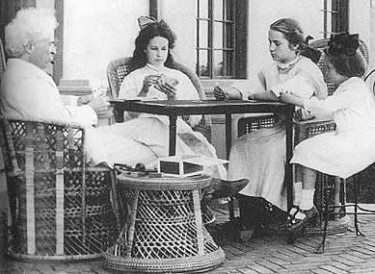
“I suppose we are all collectors,” he once wrote. “As for me, I collect pets: young girls — from ten to sixteen years old; girls who are pretty and sweet and naive and innocent — dear young creatures to whom life is a perfect joy and to whom it has brought no wounds, no bitterness, and few tears.”
The girls Twain “collected” came from all stations in life. His club included the daughters of foreign dignitaries, members of prestigious acting families as well as random souls he met out on his lecturing tours. Collectively, these girls meant so much to Twain that by the time he moved into his final home in Redding, he’d decided to name his manor “Innocence at Home” in honor of his virtuous “Angelfish.”
Numerous anecdotes tell of Twain’s meetings with these pen pals. Twain’s secretary, Isabel Lyon, recorded in her journal in April 1908: “Off he goes with a flash when he sees a new pair of slim little legs appear. And if the little girl wears butterfly bows of ribbon on the back of her head then his delirium is complete.”
Reading about such episodes through 21st-century lenses, it’s hard not to imbue these meetings with Humbert Humbertian overtones. Still, according to Harris, who told me that she mostly avoids the subject because she finds it incredibly “creepy,” the correspondences were most likely harmless. “I think it was innocent, but it’s certainly odd,” she said.
Likewise, Morris, who finds the subject equally uncomfortable, pointed out that there have never been any accusations made that Twain acted improperly with any of these girls. “You would think they would show up if that had been the case,” she told me.
Either way, Twain’s daughter Clara eventually put an end to it. Whether by outright decree or dogged campaign, on a visit home during a break from a 1908 singing tour, she convinced her father to stop hosting the young girls at the Clemens’ home. She also made sure that he trashed his Angelfish letters soon after reading them, and that he immediately changed the name of his manor from “Innocence at Home” to the name it’s still known by today, “Stormfield.”
***
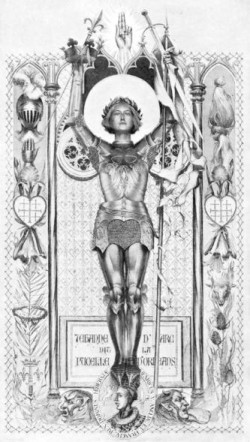
It’s probably not surprising that after so many years of adoration and advocacy, Twain would maintain a proprietorial attitude toward Joan of Arc. After the publication of Recollections, Twain waged an odd and, at times, hostile soapboxing campaign to promote his view of her.
As Joan’s story grew increasingly popular in the early 20th century, the author became progressively unhappy with the way she was being presented by other writers and artists. Anyone who chose to portray Joan as anything but “a lithe, young, slender figure, instinct with the unbought grace of youth” immediately earned Twain’s ire. “How strange it is,” he wrote in the 1904 Harper’s essay, “that almost invariably the artist remembers only one detail — one minor and meaningless detail of the personality of Joan of Arc: to wit, that she was a peasant girl — and forgets all the rest; and so he paints her as a strapping middle-aged fishwoman, with costume to match, and in her face the spirituality of a ham.”
He echoed this view in remarks to the Society of Illustrators banquet the next year. Having concluded his prepared speech, he took on a playful, yet chiding inflection to rebuke those artists in the room who had portrayed the Maid of Orleans poorly in the past, accusing some of them as having drawn Joan “with the figure of a cotton-bale.”
These “Russian peasant” portrayals of Joan — as Twain referred to them — jettisoned what the author loved most about her: chiefly her youth and her beauty. The idea that an enterprising, intelligent young woman could be depicted as somehow older than she was — or, even worse, as a predominantly masculine figure — offended him greatly. Men, after all, were intrinsically dishonest and filthy. Women, specifically young women, were naturally honest and pure.
In the end, Twain’s crusade to shape Joan’s legacy failed. By the time of his death, in 1910, the story of Joan of Arc had already been taken up by American suffragettes who used her image liberally in an effort to rally their base. The women’s rights movement had long invoked Joan of Arc’s image on flags, posters and buttons. And instead of Joan of Arc, virtuous young maiden, the suffragettes were interested in Joan of Arc, successful soldier. To those on the movement’s front lines, Joan was a stirring symbol of a woman’s ability to lead.
Joan’s beatification by the Vatican, in 1909, also brought the battle over her religious standing to its climatic final chapter. By beatifying Joan, the Catholic Church formally acknowledged her presence in heaven. After hundreds of years of controversy, the “heretic” Joan of Arc was suddenly under consideration for sainthood. Considering how and why she was killed, this was of no small consequence.
Fittingly, both Joan’s Catholic sympathizers and the American suffragettes achieved their respective victories during the same year: 1920. Joan of Arc was canonized by the Roman Catholic Church on the 16th of May, while the 19th Amendment to the U.S. Constitution was ratified three months later, on the 18th of August.
According to Harris, it remains immensely symbolic that these two monumental accomplishments occurred mere months apart. “If we think in terms of really large cultural shifts,” she told me, “the fact that both the Vatican and the United States would come to the point of sanctifying women in public — you are looking at a seismic shift in Western culture.”
Joan of Arc became a household name. In the ’20s, dozens of stage-plays, novels, moving pictures, et al told (and retold) her story. Yet, even with conditions perfectly primed for a revival, Twain’s Recollections remained largely unread — despite the enduring popularity of its author and the newfound admiration for its subject. As Joan became further identified with “The New Woman,” Twain’s book was buried beneath an avalanche of new Joan-inspired material, nearly all of it shot through with a comparatively fresher take on female empowerment.
Ultimately, it’s this hybrid quality that makes Recollections such an interesting piece of art. The book, in essence, works as a time capsule for a short-lived, diluted version of Victorianism that never really took root; one in which Twain could allow for certain political and social advancements while still retaining some very old-fashioned ideals. As Harris told me, “If you just read Recollections for Joan, it’s not a very interesting book at all. But if you read it for De Conte, the narrator, you realize that he basically becomes a voice for the book’s author.”
Viewed this way, Recollections becomes an elegy to much more than just Twain’s beloved Maid of Orleans. “I have finished my story of Joan of Arc,” reports De Conte in the book’s final chapter, “that wonderful child, that sublime personality, that spirit which in one regard has had no peer and will have none — this: its purity from all alloy of self-seeking, self-interest, personal ambition. In it no trace of these motives can be found, search as you may, and this cannot be said of any other person whose name appears in profane history.”
Daniel Crown is a freelance writer based out of Brooklyn.
Have Some Doody Chicken
The government is doing its best to make sure we all decide to go vegetarian. [Via]
Is Ryan Harrison the One American Tennis Player We Can Believe In?

Ryan Harrison, who will be 20 next month, is suddenly on the Davis Cup team, since Mardy Fish just unexpectedly quit after having “funny feelings.” (That’s a quote.) Harrison left the juniors at 16, is a chatty Twitter enthusiast and is currently ranked 66th. That makes him the 5th-highest ranked American tennis player. (They also passed right over Donald Young when picking a replacement, which, hmm.) The Davis Cup begins Friday, where they face France. So everything is thrown into an uproar, and it would be very nice to have any faith in American mens’ tennis. Anyway, no pressure, teenager! It’s not like we’re all going to judge your play and declare hope or lack thereof for American tennis for the next decade or so. Enjoy!
Birds, Everything Else, Louder Now
“City streets have got noisier in the last thirty years — and birds have ‘raised their game’ to compensate. A new study has shown sparrows sing louder, just as people do when talking, in order to be heard over city traffic noise. The study has also found San Francisco streets, where the study took place, have grown noisier since the seventies, with the birds adjusting their singing to fit in with modern day commotion.”
Where Do Liberals Say They'll Move Now if Obama Loses?

With the news that Monterrey is no longer a functioning city, with the police force literally controlled by organized crime, and Mexico City not much better, the old “I’m moving to Mexico if the Romney-Rubio ticket wins” is pretty much right out. And with the imminent collapse of the EU, moving to much of Europe — particularly Spain — seems like a not great idea. To what locale will disgruntled Americans (particularly those who can’t take the cold of Canada or Berlin or Sweden) pretend they’re going to relocate now in the event of a rightward turn in the White House? I guess Istanbul isn’t a bad choice, unless Iran gets nuked? Is the answer the newly trendy Montevideo???
